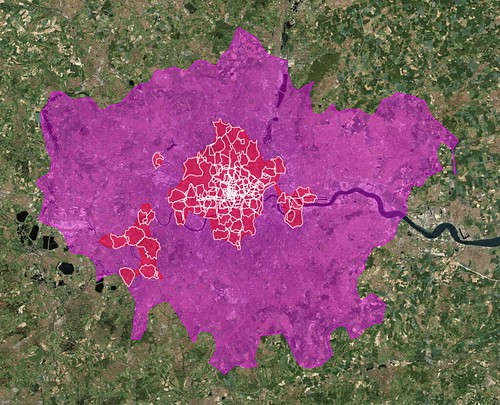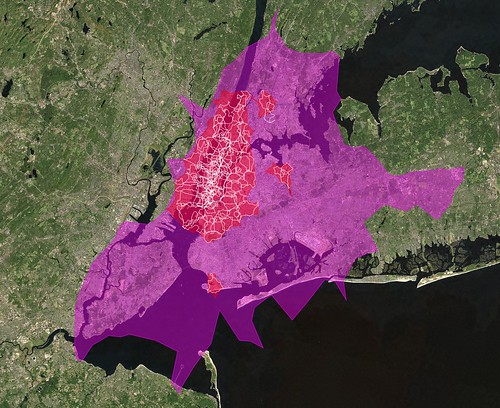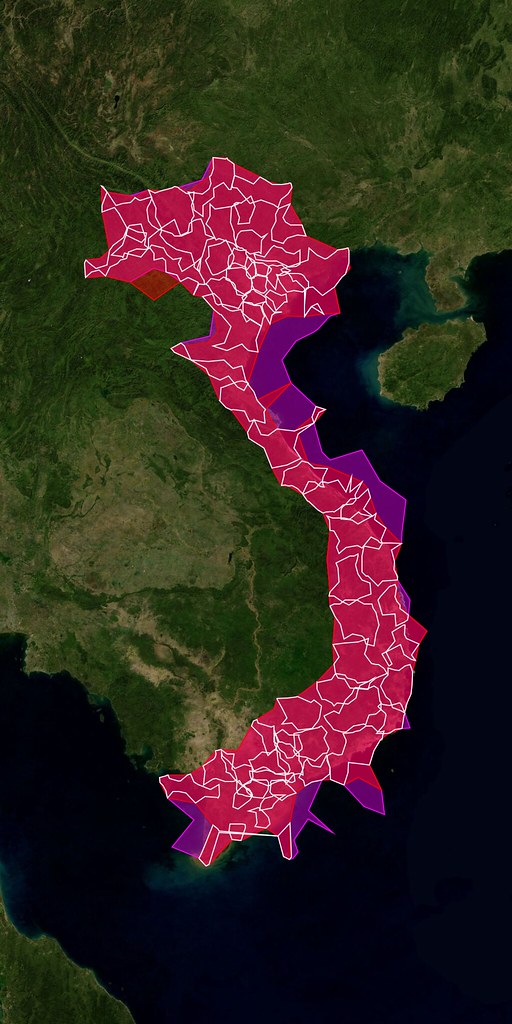Back in January, I wrote a blog post about some experimental work that I’d been doing with the shapefile data we derive from geotagged photos. I was investigating the idea of generating shapefiles for a given location using not the photos associated with that place but, instead, from the photos associated with the children of that place. For example, London:
The larger pink shape is what we (Flickr) think of as the “city” of London. The smaller white shapes are its neighbourhoods. The red shapes represent an entirely new shapefile that we created by collecting all the points for those neighbourhoods and running them through Clustr, the tool we use to generate shapes.
For lack of any better name I called these shapes “donut holes” because, well, because that’s what they look like. The larger shape is a pretty accurate reflection of the greater metropolitain area of London, the place that has grown and evolved over the years out of the city center that most people would recognize in the smaller red shape. Our goal with the shapefiles has always been to use them to better reverse-geocode people’s geotagged photos so these sorts of variations on a theme can better help us understand where a place is.
Like New York City. No one gets New York right including us try as we might (though, in fairness, it’s gotten better recently (no, really)) and even I am hard pressed to explain the giant pink blob, below, that is supposed to be New York City. On the other hand, the red donut hole shape even though (perhaps, because) it spills in to New Jersey a bit is actually a pretty good reflection of the way people move through the city as a whole.
It could play New York on TV, I think.
I’m not sure how to explain the outliers yet, either, other than to say the shapefiles for city-derived donut holes may contain up to 3 polygons (or “records” in proper Shapefile-speak) compared to a single polygon for plain-old city shapes so if nothing else it’s an indicator of where people are taking photos.
If the shapefiles themselves are uncharted territory, the donut holes are the fuzzy horizon even further off in the distance. We’re not really sure where this will take us but we’re pretty sure there’s something to it all so we’re eager to share it with people and see what they can make of it too.
(This is probably still my favourite shapefile ever.)
Starting today, the donut hole shapes are available for developers to use with their developer magic via the Flickr API.
At the moment we are only rendering donut hole shapefiles for cities and countries. I suppose it might make sense to do the same for continents but we probably won’t render states (or provinces) simply because there is too much empty unphotographed space between the cities to make it very interesting.
There are also relatively few donut holes compared to the corpus of all the available shapefiles so rather than create an entirely new API method we’ve included them in the flickr.places.getShapeHistory API method which returns all the shapefiles ever created for a place. Each shape element now contains an is_donuthole attribute. Here’s what it looks like for London:
<shapes total="6" woe_id="44418" place_id=".2P4je.dBZgMyQ" place_type="locality" place_type_id="7"> <shape created="1241477118" alpha="9.765625E-05" count_points="275464" count_edges="333" is_donuthole="1"> <!-- shape data goes here... --> </shape> <!-- and so on -> </shapes>
Meanwhile, the places.getInfo API method has been updated to included a has_donuthole attribute, to help people decide whether it’s worth calling the getShapeHistory method or not. Again, using London as the example:
<place place_id=".2P4je.dBZgMyQ" woeid="44418" latitude="51.506"
longitude="-0.127" place_url="/United+Kingdom/England/London"
place_type="locality" place_type_id="7" timezone="Europe/London"
name="London, England, United Kingdom" has_shapedata="1">
<shapedata created="1239037710" alpha="0.00029296875" count_points="406594"
count_edges="231" has_donuthole="1" is_donuthole="0">
<!-- and so on -->
</place>
Finally, here’s another picture by Shannon Rankin mostly just because I like her work so much. Enjoy!





